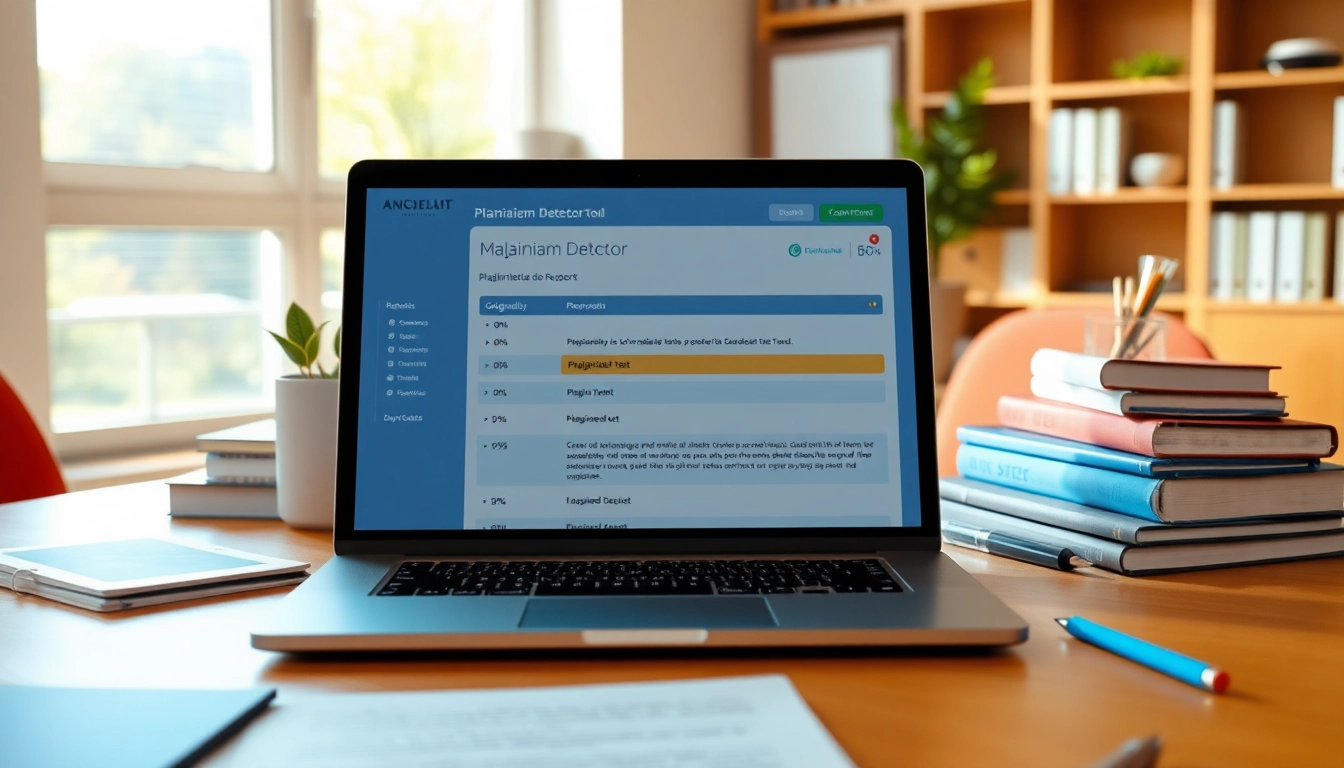Understanding Plagiarism Detectors
What is a Plagiarism Detector?
A plagiarism detector is a software tool designed to evaluate written content for similarities with other published works. The primary function of these detectors is to identify instances where the writing closely resembles existing texts, which may indicate plagiarism. These tools serve various audiences, including students, educators, and professionals, allowing them to maintain ethical standards in writing and ensuring original content throughout their projects. In the academic field, for instance, a plagiarism detector helps uphold integrity by preventing unintentional or deliberate copying of others’ ideas without proper attribution.
How Plagiarism Detectors Work
Plagiarism detectors employ sophisticated algorithms and databases to compare a submitted document against numerous online sources, academic journals, past student submissions, and books. The process begins when a user uploads a document, which the software then scans for any verbatim text, closely paraphrased sections, or even transformed sentences that retain original ideas. Advanced plagiarism detection tools utilize machine learning and natural language processing (NLP) techniques, which allow them to analyze context and semantics, improving accuracy and reducing false positives.
The Importance of Using a Reliable Plagiarism Detector
The significance of employing a reliable plagiarism detector in today’s information-rich world cannot be overstated. For students and researchers, these tools not only aid in maintaining academic integrity but also enhance their writing skills by highlighting areas that require proper citation. From a professional standpoint, organizations rely on plagiarism detectors to safeguard their reputation, ensuring that reports, proposals, and publications reflect original thought and respect intellectual property rights. Ultimately, implementing effective plagiarism detection fosters a culture of originality and accountability, essential for educational institutions and corporations alike.
Key Features of Effective Plagiarism Detectors
Real-time Scanning Capabilities
One of the critical features of an effective plagiarism detector is its ability to perform real-time scanning. Real-time scanning allows users to receive immediate feedback on potential plagiarism as they write or edit their documents. This feature is especially valuable for students working on their assignments or researchers drafting papers, enabling them to correct potential issues before submission. Furthermore, real-time feedback promotes an iterative writing process where individuals can continually improve their drafts while safeguarding against unintentional plagiarism.
Accuracy and Report Detail
Accuracy is paramount when choosing a plagiarism detector. A reliable tool must not only identify plagiarism but also provide detailed reports illustrating where the similarities exist and what sources contributed to the findings. Detailed reports often include percentages of originality, highlighted plagiarized passages, and links to the source material, enabling users to assess how to improve their work. High-quality plagiarism detectors maintain comprehensive databases to ensure that their results are as precise as possible, something that free or less sophisticated options typically lack.
Integration with Writing Tools
Another beneficial feature of plagiarism detectors is their ability to integrate seamlessly with various writing tools and platforms—such as Google Docs, Microsoft Word, and learning management systems (LMS). Integration simplifies the workflow for users, allowing them to run plagiarism checks without having to switch between applications. It also enhances user experience, making it easy for educators and students to incorporate plagiarism checks into their regular writing processes effectively.
Comparing Popular Plagiarism Detectors
Free vs. Paid Plagiarism Detectors
When navigating the landscape of plagiarism detection tools, users often encounter a choice between free services and paid options. Free plagiarism detectors can be useful for quick checks; however, they often come with limitations such as less extensive databases, fewer features, and less accurate results. Paid services, on the other hand, typically offer a comprehensive set of features, including advanced reporting, enhanced accuracy, and real-time scanning capabilities. Users should weigh their specific needs against the pros and cons of each type to determine which option best suits them.
Top Competitors in the Market
Several plagiarism detectors dominate the market, each with its own unique offerings suited for different user needs. Grammarly, for instance, combines grammar checking with plagiarism detection, making it an excellent tool for improving writing quality alongside checking for originality. Turnitin, widely used in educational institutions, is known for its extensive database and is often the go-to choice for academic plagiarism checks. Other popular options include Copyleaks, which utilizes AI technology for advanced detection capabilities, and Scribbr, celebrated for its user-friendly interface and detailed reports. Evaluating these tools based on user reviews, features, and specific use cases can help users choose the right plagiarism detector for their needs.
User Reviews and Recommendations
User reviews provide invaluable insight into the effectiveness of different plagiarism detectors. When selecting a tool, prospective users should explore testimonials and feedback from other users, paying attention to aspects such as accuracy, user interface, customer service, and value for money. Platforms like Trustpilot or educational forums can serve as excellent resources for gathering this information. Ultimately, recommendations from peers or professionals can guide users toward selecting a plagiarism detector that fulfills their requirements.
Best Practices for Using a Plagiarism Detector
How to Interpret the Results
Understanding the results from a plagiarism check is vital for effectively using these tools. When reviewing output reports, users should look for highlighted sections to identify potentially plagiarized content better. Many detectors provide percentage scores regarding originality; users should interpret these scores within context. For example, a lower originality score may be acceptable in a research paper heavily citing sources, while higher originality is expected in creative writing. Analyzing the sources linked within the report is equally crucial, as it enables users to identify where to modify phrasing or add citations.
Steps to Ensure Originality in Writing
Ensuring originality in writing involves several proactive steps beyond simply relying on plagiarism detectors. Researchers should develop a clear understanding of citation styles, such as APA or MLA, to credit sources correctly. Taking detailed notes when researching helps differentiate between original ideas and sourced material, simplifying the writing process. Additionally, employing paraphrasing techniques can reshape the presentation of information while retaining the original message. Educating oneself about common plagiarism types—like self-plagiarism or mosaic plagiarism—can also aid in avoiding pitfalls associated with writing.
Common Pitfalls to Avoid
When utilizing plagiarism detectors, users should guard against several common pitfalls. First, some individuals make the mistake of assuming that a clean report indicates perfect originality; however, documents may still lack proper citations despite passing a check. Moreover, relying solely on technology can lead to complacency in developing good writing practices. Lastly, misunderstanding results—such as failing to recognize the distinction between common knowledge and proprietary information—can lead to unintentional academic dishonesty. By being aware of these challenges, writers can foster more ethical writing practices and uphold integrity in their work.
Future Trends in Plagiarism Detection Technology
The Role of AI in Plagiarism Detection
Artificial Intelligence (AI) is set to revolutionize plagiarism detection by enhancing the accuracy and efficiency of existing tools. As AI algorithms evolve, they can analyze writing styles more effectively, distinguishing between genuine copying and acceptable paraphrasing. Moreover, AI-driven tools will likely become more intuitive, learning from user interactions and adapting to various writing contexts. This advancement will provide users with personalized feedback, ultimately refining their writing process while preventing plagiarism.
Emerging Features in Plagiarism Detectors
Plagiarism detection tools are continuously evolving, with emerging features set to redefine how users approach originality checks. Advanced contextual analysis capabilities will allow tools to understand the nuances in writing better, identifying modified or paraphrased content. Another promising trend is the integration of citation management tools within plagiarism detection software, streamlining the process of citing sources correctly. Additionally, collaborative features that facilitate group writing reviews can enhance accountability among collaborators, further ensuring content originality.
Potential Impact on Academic Standards
As plagiarism detection technology advances, there will likely be a significant impact on academic standards and expectations. Institutions may incorporate more sophisticated tools directly into their submission processes, requiring students to submit original work validated by these systems. Consequently, academic integrity will be reinforced as educational systems prioritize originality throughout curricula. Such measures will not only foster honest academic practices but also prepare students for professional environments where ethical writing is fundamental.



